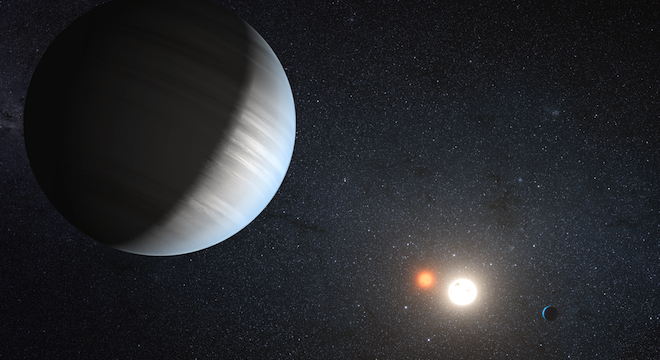Imagine a world with two different Suns in the sky, similar to Luke Skywalker’s home desert planet Tatooine in “Star Wars.” Such a world exists, as NASA announced in September 2011.
But now, NASA has found something twice as remarkable: In a different system, NASA has detected two separate planets, both orbiting the same two stars, which are in turn, both orbiting each other.
Aside from being relatively unusual, the finding also proves that multiple planets — including planets potentially capable of harboring life — can form in orbits around two different stars, a type of gravitational environment that NASA notes is “stressful,” in its news release on the discovery, published Wednesday.
NASA published the following video illustrating how the planetary system works:
The newly detected system is known as Kepler-47, named after NASA’s Kepler spacecraft, an unmanned photometer (light-sensing) instrument launched in 2009 specifically to search the Milky Way for Earth-like planets located in habitable zones around distant stars.
“Unlike our sun, many stars are part of multiple-star systems where two or more stars orbit one another. The question always has been — do they have planets and planetary systems? This Kepler discovery proves that they do,” said William Borucki, principal investigator of the Kepler mission, in NASA’s news release. “In our search for habitable planets, we have found more opportunities for life to exist.”
In this case, the Kepler-47 system is located a relatively nearby 4,900 light-years from Earth in the constellation Cygnus. Here’s a NASA graphic comparing the system and its orbits with those of the planets in our own Solar System:

It contains two stars, which orbit one another every 7.45 days.
One star is about as large as the Sun, but emitting only 84 percent as much light. The other star is much smaller and dimmer: One third the size of the Sun and less than 1 percent its brightness, according to NASA.
The two planets, by contrast, are harder to discern because they are so distant. Here’s an artist’s rendering of them published by NASA:

One planet, Kepler-47b, is three times as large as Earth (by radius).
Kepler-47b orbits both of its stars more closely than its counterpart — its year is just about 50 days long — and as such is almost certainly extremely hot. Scientists believe its atmosphere may be made of a haze of superheated methane gas.
The other planet, Kepler-47c, takes 303 days to orbit both stars. That puts it far enough away from both stars that it is in the “habitable zone,” an area nearby a star (or stars) where it’s not too hot and not too cold for liquid water to be present on the planet’s surface, if other conditions are right. Because no known life can exist without water, scientists use this indicator as an important test for determining planets that are candidates for supporting life.
Unfortunately, it’s highly unlikely that Kepler-47c actually contains either water or extraterrestrial life, as scientists believe it is a gas giant similar to Neptune.
Borucki and his colleagues published their findings in the latest issue fo the journal Science.






